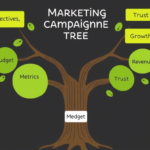Mastering Digital Marketing Analytics: The Key to Unlocking Growth for Small Businesses
In today’s hyper-competitive digital landscape, small businesses and nonprofits face a daunting challenge: how to stand out without breaking the bank. At Country Fried Creative (CFC) , my digital marketing agency, we’ve spent over two decades helping organizations navigate this challenge. One truth has remained constant throughout: data-driven marketing isn’t just a buzzword—it’s the foundation of success.
But here’s the reality: many small business leaders still struggle to track their marketing efforts effectively. They know their financials and sales numbers inside out, but when it comes to understanding how their marketing activities are performing, they’re often in the dark. Worse yet, they confuse marketing with sales—a classic mistake that can derail even the best intentions.
Let me be clear: marketing is not the same as sales , but when these two functions work in harmony, your business will thrive. In this article, we’ll focus on marketing—specifically, how to use analytics to measure and optimize your efforts across key channels like web, social media, email, and advertising. By the end, you’ll have a clear roadmap to make every marketing dollar count.
The CFC Digital Marketing Roadmap: Your Blueprint for Success
Imagine embarking on a road trip without a map or GPS. You might eventually reach your destination, but the journey would be chaotic, inefficient, and frustrating. The same principle applies to marketing. Without a clear plan, your efforts risk being scattered and ineffective.
At CFC, we use a Digital Marketing Roadmap to guide our clients through the complexities of modern marketing. This roadmap breaks down the process into manageable components, ensuring that every activity aligns with larger business goals. Central to this roadmap is analytics —the compass that keeps you on track.
Analytics provide measurable insights into what’s working and what’s not. These insights are captured through Key Performance Indicators (KPIs) , which act as guideposts for evaluating success. For small businesses with limited resources, focusing on the right KPIs can make all the difference. Let’s dive into the four essential categories of digital marketing analytics and explore how they can transform your strategy.

1. Web Analytics: Decoding Visitor Behavior
Your website is your digital home base—the first place potential customers go to learn about your brand. But are they sticking around, or leaving before you’ve made an impression? Web analytics help answer this question by providing a detailed picture of visitor behavior.
Key Metrics to Track
- Users and Sessions : Unique visitors (users) versus repeat visits (sessions). For example, a local nonprofit running a donation drive might notice higher session counts, indicating returning visitors who are interested in their mission.
- Pageviews and Popular Pages : Which pages are drawing the most attention? A small furniture maker might discover that product pages for handcrafted tables are getting the most views, prompting them to add more details or visuals to capitalize on interest.
- Bounce Rate : The percentage of visitors who leave after viewing just one page. If your “About Us” page has a high bounce rate, consider adding engaging content or internal links to encourage exploration.
- Traffic Sources : Where are visitors coming from? A neighborhood animal shelter might find that local Facebook groups drive significant traffic, signaling an opportunity to double down on social media promotions.
- Conversion Rate : How many visitors complete desired actions, such as signing up for a newsletter or making a purchase? A fitness studio offering free introductory classes online might see a spike in conversions, proving the effectiveness of this tactic.
By analyzing these metrics, you can refine your website to better serve your audience and achieve your goals.

2. Social Media Analytics: Building Connections That Matter
Social media has revolutionized the way brands connect with their audiences. It’s no longer just about broadcasting messages—it’s about fostering genuine relationships. But how do you know if your social media efforts are paying off? Enter social media analytics .
Key Metrics to Track
- Followers and Subscribers : Your follower count reflects your reach. For instance, a tourism board sharing scenic photos might see a surge in Instagram followers, highlighting interest in local travel.
- Engagement Rate : Likes, shares, and comments reveal how well your content resonates. A hardware store posting DIY home improvement tips might find that practical advice drives higher engagement. -A Click-Through Rate (CTR) : How many people clicked on a link in your post? A historic theater promoting upcoming shows might discover that “Behind-the-Scenes” videos generate higher CTRs than static images.
- Popular Content : Identify which posts perform best and replicate their success. A bakery sharing behind-the-scenes videos of bread-making might find that this format generates far more engagement than static images.
Social media analytics empower you to create content that truly connects with your audience, building trust and loyalty over time.

3. Email Analytics: Crafting Personalized Experiences
Despite the rise of social media and SMS, email remains one of the highest ROI channels for small businesses and nonprofits. When done right, email allows you to communicate directly with your audience in a personalized and meaningful way.
Key Metrics to Track
- Open Rate : How effective are your subject lines? A historical society might find that emails mentioning “Local History Events” have higher open rates, indicating what resonates with subscribers.
- Click-Through Rate (CTR) : Are recipients clicking on links within your email? A real estate agency with low CTRs might experiment with eye-catching visuals or clearer calls-to-action.
- Bounce Rate : Undeliverable emails signal issues with your list quality. A festival organizer noticing high bounce rates should clean up outdated addresses.
- Unsubscribe Rate : High unsubscribe rates could indicate problems with content relevance or frequency. A fitness center switching to weekly newsletters might adjust back to bi-weekly updates if unsubscribes spike.
- Conversion Rate : How many recipients take action based on your email? A bookstore promoting a holiday sale might track in-store purchases made using an email-exclusive discount code.
Email analytics ensure that your messages aren’t just being sent—they’re being read and acted upon.
4. Advertising Analytics: Maximizing Paid Campaigns
Gone are the days of blindly throwing money at print ads or TV commercials. Online advertising offers unparalleled precision, allowing you to target specific audiences and measure results in real-time. Advertising analytics show whether your ads are hitting the mark.
Key Metrics to Track
- Cost Per Click (CPC) : How much are you paying for each click? A pet adoption nonprofit running ads for an adoption drive might notice a low CPC, indicating efficient spending.
- Click-Through Rate (CTR) : High CTRs suggest that your ad messaging resonates. A family-owned restaurant promoting a dinner deal might see higher CTRs, prompting similar campaigns in the future.
- Conversion Rate : How many clicks lead to purchases or sign-ups? A bed-and-breakfast advertising discounted weekend stays might measure conversion rates to assess booking success.
- Return on Ad Spend (ROAS) : Compare revenue generated against ad spend. A small farm spending $200 on ads to promote fresh produce delivery and earning $1,000 achieves a 5x ROAS—a strong return.
- Customer Acquisition Cost (CAC) : What does it cost to acquire a new customer? A toy store spending $300 on Facebook ads to attract 50 new customers calculates a CAC of $6, helping them evaluate profitability.
Advertising analytics ensure that every dollar spent contributes to your bottom line.
Centralizing Insights with Dashboards
Tracking metrics across multiple platforms can feel overwhelming. That’s where dashboards come in. A well-designed dashboard consolidates all your KPIs into a single, easy-to-read view, empowering you to make data-driven decisions quickly.
For example:
- Use Google Analytics to monitor website traffic and behavior.
- Leverage Facebook Insights for social media performance.
- Rely on Mailchimp or similar tools for email analytics.
- Combine everything into a unified dashboard using tools like DashThis or Google Data Studio .
With a dashboard, you can spot trends, identify areas for improvement, and pivot strategies—all in real-time.
Bringing It All Together: A Path to Growth
If you’re like most small business owners, your plate is already full. Adding “track analytics” to your to-do list might seem daunting. But here’s the good news: analytics aren’t just numbers—they’re stories waiting to be told. Every click, open, and follow represents a real person interacting with your brand. By tracking KPIs, you gain invaluable insights into what matters most to your audience.
Here’s how to get started:
- Define Clear Goals : Whether it’s boosting online sales, growing your email list, or increasing foot traffic, start with specific, measurable objectives.
- Launch a Focused Campaign : Use data to inform your strategy. Tailor your message and choose the right channels to reach your ideal customers.
- Monitor and Optimize : Track performance in real-time and make adjustments as needed. Small tweaks can yield big results.
- Use a Dashboard : Consolidate your analytics into a single view for maximum efficiency.
The Bottom Line: Data-Driven Marketing Is Within Reach
Marketing analytics might sound intimidating, but they don’t have to be. By focusing on the essentials—web, social media, email, and advertising—you can build a data-driven strategy that delivers tangible results. Remember, every metric tells a story. Listen closely, and you’ll uncover opportunities to grow your business in ways you never imagined.
At CFC, we’ve been helping small businesses harness the power of analytics for over 20 years. Trust me—it works. Start small, stay consistent, and watch your efforts compound over time. Because when it comes to marketing, data isn’t just a tool—it’s your secret weapon.






















